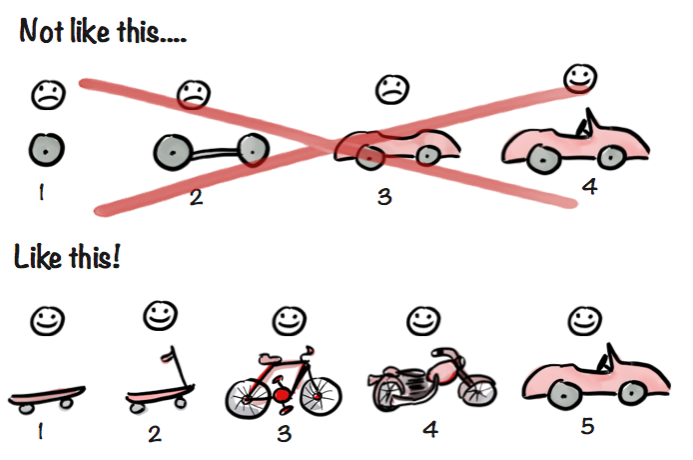
How to Build a Minimum Viable Product (MVP) in 6 Steps
Creating a totally new product and getting it to the market is always a gamble. One of the best ways to lower the risk is by building a Minimum Viable Product (MVP). The creation of MVPs has saved many founders from investing tons of money and energy into ineffectual products and features.

Leverage this article, which serves as an insightful guideline, to help new startups successfully build an MVP and avoid common mistakes. Let's go through the main points to form an understanding of how to build an MVP and find out the importance of an MVP in software development.
WHAT IS A MINIMUM VIABLE PRODUCT (MVP)?
The term MVP was coined back in 1987 by Frank Robinson, CEO of Santa Barbara-based SyncDev. According to Frank himself, an MVP is a product with the highest return on investment versus risk.
In other words, a minimum viable product definition can be thought of as the smallest possible thing you can put on the market that will still give you useful data once released.
MVP existed in many different forms over the years but its popularity exploded when Eric Ries explained the term in his book, the Lean Startup.
One of the crucial and distinctive features of an MVP is that it should be able to potentially satisfy the customers of a startup at every single stage of release, starting from the very first one. So, when creating an MVP, you aren’t just building and releasing separate pieces of your future all-inclusive product. What you are doing is creating the simplest working form of the product to keep your customers captivated.
The best way to explain this is the viral image constructed by Henrik Kniberg.

4 COMMON TYPES OF MINIMUM VIABLE PRODUCTS
We'll tell you that there might be as many types of MVPs, as many products may be developed. But of course, we can somehow categorize them to bring some order into chaos.
So, there are the main types every MVP creator should consider.
CONCIERGE MVP
When you make an MVP of this type, you don’t even necessarily have to build a product. All you need to do here is to mimic the product by offering your customers a totally manual, hands-on service.
A classical example is Food on the Table. Manuel Rosso, the owner of the company, looked for a few people who were interested in his experiment and offered them a VIP service where he interviewed them, manually looked for their desired recipes, identified their favorite ingredients, and helped them find discounts and coupons from their local stores. For all this, Paul got a $10 check after every week. What was very important for him in implementing this type of MVP wasn’t the money but to gain more insights into what his customers really wanted.
WIZARD OF OZ MVP
The Wizard of Oz is quite similar to the Concierge MVP type, except that in this case, you don’t let the customers know that your product isn’t complete yet. You find a way to give an impression that your product is already finished and evaluate their reaction – are they eager to get it right away or they simply don’t care about the existence of your product?
Nick Swinmurn, the brains behind the billion-dollar company, Zappos, implemented the Wizard of Oz MVP very well. Nick wanted to know if people are interested in buying shoes online without putting them on first. Instead of ordering dozens of shoes to try out the idea, Swinmurn simply went to other stores, took pictures and posted them online to see people’s reactions. In Nick’s case, people actually liked the idea – and they still do, Zappos is currently worth 1.3 billion dollars.
CONTENT MVP
The Purpose of a Content MVP is to build awareness about your product in such a way that you can get real feedback from your potential customers. This can be a landing page, a questionnaire, or even a demo video.
One of the most successful companies which implemented the Content MVP was DropBox mentioned above. Drew Houston, the founder of DropBox, simply created a 3-minute video explaining his idea. This alone was enough to create an explosion of interest and allow him to validate his concept from his customers’ perspectives.
SOFTWARE PROTOTYPE
When it comes to tech-savvy products such as Saas or Android and iOS apps, the best MVP application type is a software prototype. The basic requirements are that it should contain the core features and essential components needed to make it appealing to early adopters. In this case, it is also very essential to implement Agile project management. Most tech companies, especially smartphone manufacturers like Apple and Samsung implement this type of MVP.
These are not the only MVP types that exist. There may be various other types of MVPs you can implement (or combinate) as long they do not deviate from the core principles of a minimum viable product.
6 STEPS TO BUILD A SUCCESSFUL MVP
These steps to build an MVP will help to plan actions in practice.
DEFINE THE PROBLEM
Ask yourself the following questions:
1. Which problem am I solving and what is the magnitude of the problem?
2. How many people will benefit from my solution and where are they located?
Before committing to the real serious development of your MVP, you need to be sure that it solves a problem that people care about. After identifying the problem that your product is going to solve, you also need to know the people interested in your solution. Defining your target audience will help you to make informed decisions about where to release your product and when. Furthermore, it’s possible to spend tons of time and money developing a product that already exists. Market research helps to prevent such surprises.
SCRUTINIZE YOUR COMPETITORS
In the case that your MVP already exists as a complete product on the market, you have to evaluate whether you have a chance to outperform your competitors or not. Usually, the only way you will be able to outdo your competitors is by adding extra or unique features to your product.
GET ACQUAINTED WITH YOUR USER FLOW
Successful inventors are those who get out of their geeky shoes and look at their product from their customer’s perspective. That way, you will be able to properly experience the stages that your customers have to go through before they can achieve the main goal. As a result, you will be able to pinpoint the inconveniences your customers come across during the process so that you can introduce relevant solutions. The main goal is not to only add value but also to simplify the whole process.
DEFINE SUCCESS CRITERIA
Now that you know the user flow, it's time to go ahead and create a roadmap. A simple roadmap can be just a simple list of all the basic and crucial features that you will want to include into your MVP. A better way to do, it is to list in terms of main features and then adding sub-features under each. At this stage, you don’t yet have to limit your ideas, just list all the possible ways your creativity offers you. While doing this, mind your customers. They may actually like those features that you think are unnecessary, and vice versa.
After listing all the features, the next step is arranging them in order of priority, starting with the highest to the lowest. Last but not least, you should allocate a timeline as to when you will implement each of the features into your product. This template, or a principle, will help you define the essential features to include into the first version, and strike out others which should wait till the next versions of the product.
DEFINE THE MVP
This is probably the most interesting stage. A minimal viable product is built from the high priority and basic features on your list. These features are the definers of your MVP and are key in your project management plan. When building your MVP plan, yes you should put minimal features but the product should be viable i.e. it should not be a substandard product. A good minimal viable product should be engaging and useful for its users.
CHOOSE AN EXPERIENCED TECHNICAL PARTNER
The next step is the creation of an MVP itself. You should choose a reliable technical partner who can insightfully draft a product development plan and implement it for the first release.
So, just follow these steps to create an MVP with maximum success and avoid the pitfalls we list below.
5 KEY MISTAKES WHEN DEVELOPING AN MVP
Not every shortened product is actually an MVP. Below are seven common mistakes you should dodge when building an MVP for startup.
SKIPPING MARKET AND COMPETITOR RESEARCH
These two are very crucial and skipping them will mostly result in frustration as you discover that there are already a lot of other similar products and you don’t have any competitive advantage to help you survive the competition.
WANTING A COMPLETE PRODUCT
One of the biggest mistakes is the conviction that an MVP has to be totally bug-free and complete. In fact, this is actually the opposite to what an MVP really is. You should carefully choose what features to include at the MVP stage and what to exclude, and should not expect it to be a flawless jam.
OVER-FOCUSING ON MINIMIZATION
Another common mistake is to concentrate too much on minimalism and end up releasing an MVP with extremely basic and useless features for potential customers. So, the balance matters.
DODGING THE PROTOTYPE PHASE
A prototype basically brings your ideas to life. Without a prototype, it becomes difficult to demonstrate the feasibility of your ideas to investors and also your fellow team members working with you.
EMPLOYING AN INEXPERIENCED TEAM
In order to succeed, you need a good team experienced in building MVP products. This will help you to jump common pitfalls like overestimation, overbudgeting, or just the creation of a low-quality product.
IGNORING USER FEEDBACK
Whatever the case you should not ignore your customer’s needs, keep in mind that you should constantly gather their opinions on your MVP and draw proven conclusions.
If doing any of the above mistakes you risk getting something different from an MVP. It may be not minimal, not viable or even not a product.
IMPORTANCE OF MVP DEVELOPMENT FOR THE SUCCESS OF YOUR STARTUP
Substantially, MVP gives a new company the possibility to:
VALIDATE A NEW IDEA
No matter how much you invest in research, you can never accurately predict today’s market. MVP testing allows you to practically test the efficiency and relevancy of your idea in the real world and get quality feedback.
EXPERIMENT AT LOW RISK
A business that starts with an MVP requires minimal investment in terms of both time and money. Since it’s more or less of a mock-up, in the case that an MVP fails, you can always use the remaining funds to change the MVP in order to get better chances of success than the previous version.
SAVE THE MONEY
As mentioned earlier, you just need the core functional features to create a minimum viable product. The fewer features the less money is required for development compared with the development of a big product.
DO QUICK AND INSIGHTFUL DEVELOPMENT
Building an MVP is much quicker than building the whole product at once. And changing an MVP after testing is also quicker (and less painful) than with a big product.
PROVE TO INVESTORS
You might have a hard time convincing an investor if you don’t have something touchable and promising like an MVP. The more successful your MVP is, the better your chances of being noticed by investors.
All these benefits made the MVP approach extremely popular. And yes, it has proven its rationality over years.
MINIMUM VIABLE PRODUCT EXAMPLES
Among the world-famous products that began with the MVP are such giants as Amazon, Dropbox, Foursquare, Zappos, Airbnb, and Facebook. And we have already mentioned most of them when considering MVP types.
Also as one of the successful examples, you can see our case of creating a media monitoring platform called LOOQME.
Our task was to create a universal platform that is able to collect and analyze information from all open sources. At the same time, the product had to unify all types of media in one format, load information from more than 10,000 different media sources into a single database, have a clear and convenient interface for clients, as well as automate reporting.
As a result, the customer wanted to complete these tasks and launch a prototype of the system in 1 month.
Here you can find all the details regarding the solution and its implementation, but looking ahead, we can say that we were able to successfully launch the product within the specified time frame, and later the system acquired additional functionality and improvements on the customer's side.
BUILDING AN MVP WITH GEARHEART
Here in Gearheart, we have vast experience in building MVPs for different companies which then gained multi-million investments. It's something we actually specialize in — planning and creating minimum viable products before launching to the market.
Over the years we have mastered the MVP development services so that:
- the client could stay on top of the process knowing each and every task status;
- the first version of an MVP could be ready as soon as in 2 weeks from the first code line written;
- each next one-week sprint released a working product, according to the MVP principle.
One of our clients was able to successfully present his product on the Demo Day event in the Y Combinator seed accelerator less than in 1 month after we started working on. Yes, it was a challenge, and yes we completed it.
All this is possible thanks to hiring professional and experienced developers and managers who really know what to do, and also to our years of experience precisely in the creation of MVP products.
Go from idea to launching your own MVP. We are ready to discuss your vision and answer more questions on how to create an MVP.
FAQ
- What are the steps to build an MVP?
Follow these steps to create an MVP with maximum success and avoid mistakes:
Define the problem
Scrutinize your competitors
Get acquainted with your user flow
Define success criteria
Define the MVP
Choose an experienced technical partner - How to create an MVP’s plan?
When building your MVP plan, you should put minimal features but the product should be viable. A good minimal viable product should be engaging and useful for its users. So, first you need to prioritize and specify the top features on your list. - Where can you get answers on how to create an MVP?
Read our blog or just contact our team.
Subscribe for the news and updates
FAQ
What are the steps to build an MVP?
How to create an MVP’s plan?
Where can you get answers on how to create an MVP?



